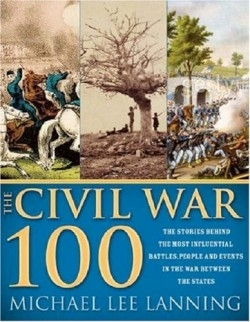The Civil War 100
The Stories Behind the Most Influential Battles People and Events In the War Between the States
“Good! Now we shall have news from hell before breakfast,” quipped General Sherman upon hearing of the battlefield deaths of three pesky journalists. Damned by faint praise, these underappreciated war correspondents and their ilk earned a modest ranking of sixty-first among the one hundred jockeying contenders of the Civil War 100.
Across this easily accessible reference, readers meet not only such icons as Lincoln and Lee, but also chronic fumblers whose tarnished reputations have most often sunk beneath the notice of the endless waves of Civil War histories. Within these pages both the lauded and the loathed take their respective positions as heroes or incompetents, while whole campaigns and singular catastrophes also earn their rightful and final grade.
Ranking the relative positive and negative contributions of North and South would seem a daunting undertaking. Not so for this son-of-the-South author. Named after General Lee, he is a retired U.S. Army lieutenant colonel and Vietnam veteran who has penned two similarly themed tomes: The Battle 100 and The Military 100. In total, he has written sixteen military histories with more than one million copies in print.
This volume is not meant to be read in a traditional linear fashion. Passing over the beginning of the war at fiftieth-ranked Fort Sumter and its final battle at Palmito Ranch (ranked 100th), the author places the most significant event of the war somewhere nearer the chronological middle: the Battle of Antietam.
Antietam gains the crown not because of its “more than 23,000 American” casualties, but because this Union victory provided the catalyst necessary for Abraham Lincoln to issue his Emancipation Proclamation, a document that altered the fundamental basis of the war from ideals of union and secession to those of freedom. These two coinciding events are what convinced England and France to stay out of the Union’s fight with the doomed Confederacy.
While readers could quibble about the exact positioning of any given person or event of Lanning’s list, they would be hard pressed to alter its contents, the strength of which lies in its villains.
John Wilkes Booth takes the stage here mostly for what might have been if not for his ill-advised (and seventy-fifth-ranked) assassination of Abraham Lincoln. While the prewar election of Lincoln was reviled by the South and directly led to its secession from the Union, the postwar murder of Lincoln deprived the South of her then greatest ally and protector in the North. Without Lincoln’s guidance to weave together the fabric of reconciliation, a vengeful North instead strained its reconstruction through the cloth of retribution.
General McClellan, while not a willful villain, was an unwitting one. During his career, most notably in the Peninsular Campaign and then at the Battle of Antietam, it was within his power to have defeated significantly smaller Confederate forces and to have potentially ended the war. Instead McClellan hesitated while requesting more reinforcements for an enemy he already outnumbered. After a squandered opportunity at Antietam that cost McClellan his command for the second and last time, Lincoln is said to have remarked, “Sending reinforcements to McClellan is like shoveling flies across a barn.”
Noteworthy Northern honorees include General Sherman’s “total war” and General Sheridan’s “scorched-earth” policies that recognized the necessity in modern warfare of removing an enemy’s ability to gain supplies. Sheridan’s burning of the Shenandoah Valley prompted his claim that “a crow flying over the region would have to carry its own provisions.” He went on to add, “I would rather win by burning a man’s farm than by killing his sons.”
Rising for the South, thirteenth-ranked Confederate General James Longstreet is sometimes blamed for the loss of the Civil War because of his continued backing of defensive strategies. “In reality,” writes the author, “the Confederacy would have endured for a longer period and possibly not have lost the war if it had followed Longstreet’s advice.”
Despite several naturally overlapping rankings and corresponding explanations, this volume earns its stripes when it highlights and illuminates the oft-forgotten contributions of ordinary black soldiers, the horrors of Andersonville prison, the use of revolutionary ironclad technology, the worldwide influence of the bestseller Uncle Tom’s Cabin, and such inspirational songs as Dixie and The Battle Hymn of the Republic.
This book is a recommended reference for the aficionado and the uninitiated alike. Those well versed in Civil War lore will enjoy the intellectual challenge of supporting or debunking Lanning’s rankings, while the merely curious will be exposed to an insightful world of detail that they may have otherwise missed.
Disclosure: This article is not an endorsement, but a review. The publisher of this book provided free copies of the book to have their book reviewed by a professional reviewer. No fee was paid by the publisher for this review. Foreword Reviews only recommends books that we love. Foreword Magazine, Inc. is disclosing this in accordance with the Federal Trade Commission’s 16 CFR, Part 255.

